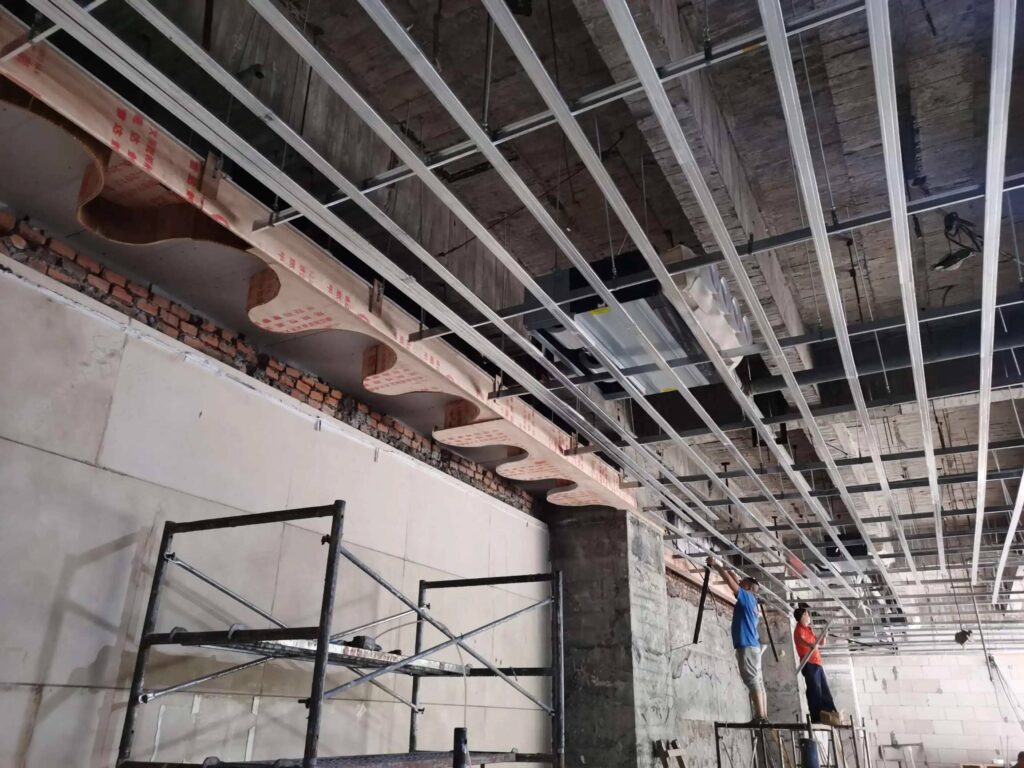
The ceiling reflects the facade of the houses, conceals the hidden, and ensures aesthetic appeal. Many people use the condole ceiling. Although it initially enhances the home, cracked ceilings can inadvertently produce the opposite result. Ceiling cracking is common. This article discusses the causes, preventative measures, and crack treatments.
Part 1: Identifying the underlying causes of suspended ceiling crack formation.
The condole ceiling often experiences cracking problems. Many decorators often encounter this problem. Why does this happen? Numerous reasons exist, as discussed below.
Skeleton material: Inadequate quality skeletons impact overall strength, causing ceiling cracks and deformation. For example, insufficient stiffness or alignment of ceiling steel profiles and hanging hooks can lead to internal stress, causing gypsum board distortion and cracking during displacement.
Covering material: Plasterboard, a common covering material, is secured by high-strength self-tapping screws and ceiling steel profiles. If the plasterboard fails to meet quality standards, it cannot be securely affixed between the two. External forces can induce shear at the gypsum board joint, resulting in joint cracking.
Jointing materials: Jointing materials typically include jointing belts and jointing putty. Jointing belts should exhibit strong adhesion and strength, while putty should possess both strength and adhesion, along with toughness and superior construction performance. Failure to meet these requirements can lead to cracking.
Hanging hooks: The hanging hook itself bends, gradually straightening under gravity post-board installation, resulting in uneven subsidence of the ceiling steel profile and gypsum board surface, resulting in joint cracking.
First, substandard construction materials pose a risk.
Suspended ceilings incorporate many materials, and problems with them can easily manifest themselves. The materials mentioned above may cause the ceiling to crack.
Second, non-standard installation methods can create problems.
Mishandling the installation of the ceiling steel profile and gypsum board can result in post-construction stress release, leading to cracking when the stress exceeds the tightening force.
① Non-standard hanging hook installation.
Improper installation of the hook results in improper fastening by pulling and blowing bolts, creating potential stress on the ceiling steel profile.
② Improper plaster board fixation.
Lack of installation specifications from the middle to the four sides of the screws during plasterboard installation can cause stress, potentially leading to cracking. In addition, improper screw spacing or non-fastening can also cause cracking.
③ Insufficient moisture-resistant treatment.
Wooden frame profiles require moisture-resistant treatment to prevent moisture-induced cracking. Gypsum board, too, is susceptible to moisture, and improper drilling can lead to board cracking.
④ Inadequate putty scraping process.
Differences in gypsum board and wall, and isothermal shrinkage or shrinkage of wood plywood can lead to putty cracking due to improper material handling. Rapid drying, excessive seam length, slow solidification, and excessive layer thickness can contribute to cracking.
Third, inadequate finished product protection can lead to damage.
Post-foundation work may involve other types of work. Coordination between these works, if lacking, can lead to ceiling cracking. For example, improper lamp-hole opening can cause ceiling vibration and cracking. In addition, inadequate daily maintenance after hidden pipe ceilings and equipment maintenance can lead to deformation of the ceiling’s steel profile or face damage, leading to ceiling cracking.
Part 2: Prevention of Suspended Ceiling Cracking.
As the adage suggests, pinpoint the origin of the disease with the right medication. The previous article detailed the reasons for the crack in the ceiling. Herein lies a study on developing specific measures to reduce the probability of ceiling cracking.
First, material selection is vital.
①Ceiling framing material selection.
Steel profile selection should strictly adhere to design specifications and quality standards. Wood profiles should not exceed moisture content. Profile specifications and types should be reviewed, not excessively minimal.
②Ceiling facing plasterboard selection.
At present, the market offers include common plasterboard, waterproof plasterboard, fireproof plasterboard, high-strength plasterboard, etc. Decorative market paper gypsum boards are of high quality. Opt for gypsum boards from reputable manufacturers, with high strength, toughness, even foaming, and plump edge molding.
In addition, paper plasterboards are available. Generally, it comes in 9 mm and 12 mm thicknesses. While 9 mm plain paperboard is popular, its thinness and low strength make it susceptible to deformation in humid conditions. It is recommended to use 12mm or thicker plasterboard. Thicker plates also prevent joint cracking.
Second, installation and construction must be standardized.
①Hanging hook installation specification.
Hanger spacing should be maintained at 1200mm, fixed points should be equidistant, and hangers should be aligned with gravity. Suspension should be secured in unobstructed areas. Steel bridge supports should be designed to distribute the suspension evenly. Suspended ceiling frames and steel profile panels should not be connected to pipeline equipment, and suspension rod supports should have adequate clearance to prevent resonance damage.
②Ceiling steel profile frame installation specification.
The main channel of the suspended ceiling should be within 1000mm, and the distance between the hanging hook and the end of the main channel should not exceed 300mm. If it does, additional hooks should be installed. The horizontal overlap of the ceiling carrier should be firm, and the hand support should not be loose during inspection. The ceiling carrier lapping gap should not exceed 2mm. Construction should strictly follow the construction drawings and specifications, without arbitrary increases in the ceiling steel profile or suspension steel spacing. The installed frame must be stress-free, without virtual hanging or virtual phenomena, and the overall ceiling steel profile frame level should be regulated.
③Plasterboard installation specification.
Gypsum board interfaces should be installed with a cross-braced ceiling steel profile, preventing the board from sagging. If transverse joints are not feasible, dislocation seaming should be implemented, staggering partition board transverse joint positions. Plasterboard performance and deformation depend on direction, with longitudinal performance superior to transverse. Therefore, the longitudinal and overlaid ceiling steel profile of plasterboard should not be parallel when suspended, but perpendicular, which is an essential measure to prevent deformation and joint cracking.
④Sealing putty specification.
A gap of 5-8mm should be left between the base plate and the base plate, filled with enough small gap putty. The seam should be applied as late as possible, dried, and then taped. Putty shrinks when hardened, so double-layered construction is required to prevent cracking. All bonded gauze or Kraft dry hard paper can be covered with ash after the second putty dries hard.
Third, finished product protection measures must be in place.
To prevent cracks in the suspended ceiling due to vibration, ensure that the opening position of the lamp and the wind gap are not in the position of the ceiling steel profile, reducing the phenomenon of splicing cracks caused by the vibration of the ceiling caused by the cutting of the ceiling steel profile for the opening of the lamps. In addition, the opening of the lamp hole, the air gap, and the maintenance opening must be completed before the joint, eliminating the vibration of the ceiling caused by the crack.
Part 3: Discussion on ceiling cracking and treatment strategies. Examine the root causes of ceiling cracks and suggest preventive inspection measures before decoration to reduce the likelihood of ceiling cracks. Often, damage is only detected after a fissured ceiling appears. What should be done when faced with this problem?
1.Crack Analysis
There are many causes of ceiling cracking, each requiring specific repair approaches. After cracking, careful analysis of the origin of the crack must be carried out to pinpoint the pipe problem before formulating a rest plan. Failure to do so could lead to a cycle of pointless crack repair.
2. Paint-Cracking Surface Repair
Linear, polygonal, or amorphous cracks on the ceiling film indicate minor problems. Brush thickness, loose base, primer/top coat mismatch, etc., may be to blame.
Repair measures: Remove the affected film, avoid excessive film thickness per application, ensure the first layer is dry before reapplication, seal the base with a suitable primer, use flexible products for rough bases, avoid latex paint below 5°C, and match primer and top coat.
3. Temperature-induced Ceiling Cracking Caused by Temperature
Temperature-induced cracking, typically occurring on the surface, does not compromise ceiling safety. Surface treatment is recommended.
Small Gap: Apply a layer of kraft paper to the gap, then brush the finished paint.
Wide Gap: Cut a piece of gypsum board, polish it, fill the gap, and brush the finished paint.
4. Improper Construction Caused Ceiling Cracking
Suppose the cracking is due to improper ceiling frame or gypsum board installation. In that case, the repair should begin with the inspection keel, address the basic quality, and proceed with the decoration article. However, the next step is not limited to seam repair with putty, but should also include repairing the original seam near the ceiling steel profile after opening some plate seams, to alleviate internal stress under deformation. If the problem is serious, the original ceiling has been deformed, swollen, or damaged. Expand the removal area, level the ceiling steel profile, replace the new plate, and complete the repair work sequence following standard construction steps.

